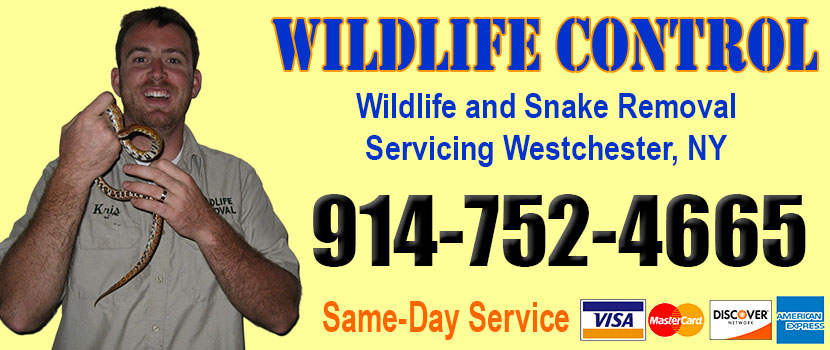
Welcome to westchestersnakes.com! I am David, a snake enthusiast living in Westchester, NY. Many people don't know that Westchester is in fact full of snakes! You just need to know where to find them - they can often be shy and elusive. Some New York snake species are more common outside of the city limits, in different parts of Westchester County NY, but many types of snakes are indeed common in the more urban parts of Westchester. This guide is meant to help educate you about the beautiful snakes of Westchester, and to help you identify the most common snakes of Westchester, as well as the venomous snakes of Westchester that you should learn to recognize and avoid. If you want more detail, click here for my complete list of ALL snake species in Westchester. Remember the following:
- Most snakes of Westchester are harmless and don't want to encounter you
- Venomous snakes exist but are uncommon in Westchester, New York
- Snakes eat rats and mice and are a valuable part of the New York ecosystem
- Never kill a snake - if you leave a snake alone, it will leave you alone.
Common Snake Species in Westchester
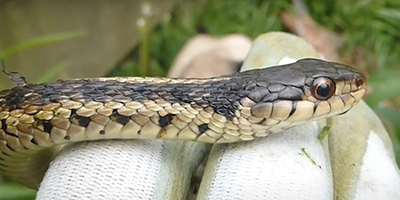 Eastern garter snake:
Eastern garter snakes are 18-26 inches in length but there have been reports of eastern garter snakes reaching up to 49 inches. Sometimes people find it hard to tell eastern garter snakes apart from other snakes but the one physical feature that helps distinguish them is the three bright yellow stripes that run down their body and catches the eye immediately. However, the three stripes are not prominent on every eastern garter snake and some eastern garter snakes have checks on their body and very light stripes along with it.
Eastern garter snake:
Eastern garter snakes are 18-26 inches in length but there have been reports of eastern garter snakes reaching up to 49 inches. Sometimes people find it hard to tell eastern garter snakes apart from other snakes but the one physical feature that helps distinguish them is the three bright yellow stripes that run down their body and catches the eye immediately. However, the three stripes are not prominent on every eastern garter snake and some eastern garter snakes have checks on their body and very light stripes along with it.
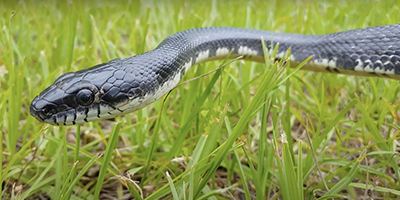 Eastern rat snake:
The eastern rat snake was previously famous for being called the black rat snake. They are harmless and non-venomous meaning that they pose absolutely no threat to human beings. The length is usually between one and two meters long. Their body appears shiny due to the shiny black scales. Their chin and belly are light-colored. The body of the eastern rat snake is much narrower than its head. They are excellent at swimming and climbing which makes them excellent predators who can catch food in a lot of ways.
Eastern rat snake:
The eastern rat snake was previously famous for being called the black rat snake. They are harmless and non-venomous meaning that they pose absolutely no threat to human beings. The length is usually between one and two meters long. Their body appears shiny due to the shiny black scales. Their chin and belly are light-colored. The body of the eastern rat snake is much narrower than its head. They are excellent at swimming and climbing which makes them excellent predators who can catch food in a lot of ways.
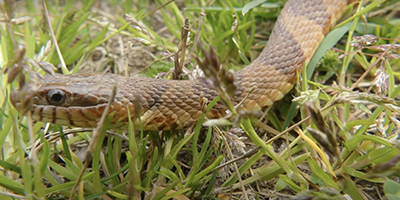 Northern water snake:
Northern water snakes can be easily found in Westchester. They are one of the most common and known water snakes. There is no one fixed color of their body as it can vary extensively from gray to brown or tan to buff. Adults are much lighter colored than the young northern water snakes who are bright and vibrant. Since northern water snakes have crossbands as well, they are confused with other snakes such as cottonmouths and copperheads. However, unlike these snakes, northern water snakes are harmless and non-venomous.
Northern water snake:
Northern water snakes can be easily found in Westchester. They are one of the most common and known water snakes. There is no one fixed color of their body as it can vary extensively from gray to brown or tan to buff. Adults are much lighter colored than the young northern water snakes who are bright and vibrant. Since northern water snakes have crossbands as well, they are confused with other snakes such as cottonmouths and copperheads. However, unlike these snakes, northern water snakes are harmless and non-venomous.
Venomous Snake Species in Westchester
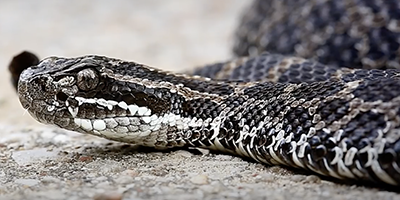 Eastern massasauga rattlesnake:
Eastern massasauga rattlesnakes are relatively smaller in size (with the average length being only 2 feet) as compared to other snakes and have thick bodies. They have vertical pupils and a head that resembles the shape of a heart. Fully grown eastern massasauga rattlesnakes are grayish light brown featuring blotches on their bodies; large blotches on the snake's back while relatively smaller blotches on the sides. The younger eastern massasauga rattlesnakes have similar markings but differ in color as they are more vivid and bright. They are often confused with fox snakes, hognose snakes, and also milk snakes.
Eastern massasauga rattlesnake:
Eastern massasauga rattlesnakes are relatively smaller in size (with the average length being only 2 feet) as compared to other snakes and have thick bodies. They have vertical pupils and a head that resembles the shape of a heart. Fully grown eastern massasauga rattlesnakes are grayish light brown featuring blotches on their bodies; large blotches on the snake's back while relatively smaller blotches on the sides. The younger eastern massasauga rattlesnakes have similar markings but differ in color as they are more vivid and bright. They are often confused with fox snakes, hognose snakes, and also milk snakes.
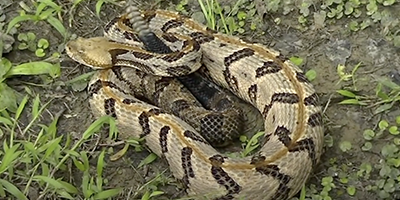 Timber rattlesnake:
Timber rattlesnakes are usually 36-60 inches in length; the largest timber rattlesnake ever was 74.5 inches. They do not have smooth dorsal scales; they are keeled and also feature 21-26 scale rows in the middle of the body. The ventral scales differ for both the genders; males have 158-177 while females have much more scales from 163-183. If we observe the snake dorsally, timber rattlesnake have crossbands that are brownish-black while the background skin can vary from shades of yellow to grey. The crossbands are not regular and have rough zig-zag edges. Some timber rattlesnakes are entirely black due to melanism.
Timber rattlesnake:
Timber rattlesnakes are usually 36-60 inches in length; the largest timber rattlesnake ever was 74.5 inches. They do not have smooth dorsal scales; they are keeled and also feature 21-26 scale rows in the middle of the body. The ventral scales differ for both the genders; males have 158-177 while females have much more scales from 163-183. If we observe the snake dorsally, timber rattlesnake have crossbands that are brownish-black while the background skin can vary from shades of yellow to grey. The crossbands are not regular and have rough zig-zag edges. Some timber rattlesnakes are entirely black due to melanism.
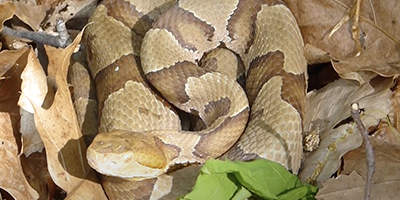 Northern copperhead:
Northern copperhead snakes have extremely thick skin. Like a lot of other venomous snakes, they too have keeled scales. Similar to their name, the northern copperhead snakes are usually in shades of copper with no striking markings on their head; they also have crossbands on their body that are mostly chestnut brown and shaped like an hourglass. Northern copperhead snakes have a heat-sensitive pit which helps them in detecting any prey nearby as it observes the heat changes in the environment and alerts the snake of nearby threats.
Northern copperhead:
Northern copperhead snakes have extremely thick skin. Like a lot of other venomous snakes, they too have keeled scales. Similar to their name, the northern copperhead snakes are usually in shades of copper with no striking markings on their head; they also have crossbands on their body that are mostly chestnut brown and shaped like an hourglass. Northern copperhead snakes have a heat-sensitive pit which helps them in detecting any prey nearby as it observes the heat changes in the environment and alerts the snake of nearby threats.
If you're unsure, you can email me a photo of the snake at info@westchestersnakes.com and I will email you back with the snake's species. If you found a snake skin, read my Found a Skin? page, and you can email me a photo of the skin, and I'll identify the snake for you. If you need professional Westchester snake removal help, click my Get Help page, or see the below website sponsor I found, who provides that service.
A Complete Guide on Black Rat Snake
Black Rat Snake, also known as the Eastern Rat Snake, is a non-venomous snake that can grow at about 3.5-7ft, making it relatively large. When these snakes feel threatened, they will release a foul musk to discourage the predator from attacking. The musk will resemble the scent of the snake's venom. They will undergo brumation during colder months, which is quite similar to hibernation. They will typically remain asleep but will be active to do essential activities such as drinking water.
What is the Appearance of the Black Rat Snake?
This snake is the biggest serpent in West Virginia. There are instances when they can grow to more than 8ft. The cross-section on this snakes' body will not be round; it will mostly resemble a loaf of bread. They have weakly-keeled dorsal scales and smooth lateral scales. The body of an adult black rat snake will be dark on the side. Whiter, red, and yellow skin areas will appear between the scales that will show the blotched pattern they have when they were juveniles. They have a bright white ventral side, especially on the neck and the throat area. The pattern of the juveniles will be distinct that includes 28-40 black to dark brown blotches. As they grow old, the pattern will become less visible.
Where is the Habitat of the Black Rat Snake?
The Black Rat Snakes usually are dwellers of the woodland. Nonetheless, they can also be found in a range of habitats like open fields, mountain ledges, rocky hillsides, and swamp borders. They can also be located near the communities, such as farm buildings, yards, and houses, to obtain their food. They will climb trees and hide on the hallowed part of the trees when searching for food. They can be found in the entire state of West Virginia. They inhabit the eastern and central US.
What is the Feeding Habit of the Black Rat Snake?
The Eastern Rat Snakes are adept climbers and swimmers. These skills are fundamental when hunting for food. They feed on eggs, birds, and frogs. You will likely find them in the developed communities, living in our yard and hunting for young birds, amphibians, and rodents. They are constrictors; they will coil their body on their prey and swallow them whole. The juveniles will feed on small rodents, lizards, and tiny frogs. When they are threatened, they will be motionless. They will vibrate their tails and will release a malodorous scent.
What is the Reproduction and Life Cycle of Black Rat Snake?
The snake will emerge from their brumation from March-May and will look for a potential mating partner from April-June. The female will reach their sexual maturity when they are four years old. The male snakes will be releasing pheromones that will send signals to receptive female snakes. After five weeks, they will lay around 12-20 eggs in a hollowed log or under the leaves. Incubation will take 65-70 days, and they will live for approximately 10-15 years. In captivity, these snakes can live up to 30 years.
Remember, the term is not poisonous snakes of Westchester, it's venomous snakes of Westchester. Poison is generally something you eat, and venom is injected into you. That said, dangerous snakes are very rare in Westchester. The few venomous snakes of Westchester County are rarely seen. But they are commonly misidentified, so learn about all the snake species of Westchester in order to correctly identify them. These snakes are usually also found in the surrounding towns of New Rochelle, White Plains, Yonkers, Scarsdale, Mount Vernon, Mamaroneck, Bronxville, Rye, Tarrytown, Peekskill, Ossining, Mount Kisco, Eastchester, Harrison, Valhalla, Larchmont, Chappaqua, Hartsdale, Pleasantville, Dobbs Ferry, Armonk, Croton-on-Hudson, Elmsford, Bedford, Cortlandt, Yorktown Heights, Rye Brook, Hastings-on-Hudson, Pound Ridge, Katonah, Briarcliff Manor, Village of Pelham, Ardsley, Irvington, Thornwood, Sleepy Hollow, and the surrounding areas.
Read our article about:
What causes a snake to bite someone?
westchestersnakes.com domain and hosting costs made possible by the generous support of this sponsor:
